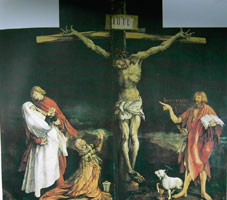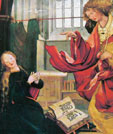Short Essay Concerning the Central Panel of Grünewald's Isenheim Altarpiece
Colmar, Unterlinden Museum, Oil on Wood, c. 1515
Kate Robinson 2001
…set yourself to rest in this darkness as long as you can, always crying out for him whom you love, For if you are to experience him or to see him at all, insofar as it is possible her, it must always be in this cloud and this darkness…
The Cloud of Unknowing
(Anon, 14th Century)

There is an infinity of tangible blackness in the sky of Grünewald's painting of the Crucifixion for the Isenheim Altarpiece. Darkness is the ground of the painting. It is the underlying chord; more than a background, it is the base, the foundation, the dimension in which the rest of the painting can be understood. Darkness is the space that the protagonists inhabit. Pictorial depth is suggested by a low, flat, green horizon, like a massive floating rock. Below the rock is more darkness before we see the pebbly brown ground on which the characters, themselves, appear to stand or float. The figures are at the very front of the picture space, in a line; John the Baptist's toe touches the edge of the canvas, Mary Magdalene's dress drapes along the edge of the frame. They are all thrust forward; they are in our faces - seen in relation to that infinite sky and that low green hill.
And out of the deep dark floats full-bellied Mary in a stone white dress. Her face is still, her eyes closed. She's falling back in a dead faint into the arms of John. Her hands are clasped before her, held out towards the crucified Christ, as though he is there in the pressing of the palms of her hands, as though if she were to clasp Him it would be her one line of life. Standing behind her, John forms a red halo around Mary's stiffened white body. Together they form a Pieta, with the usual roles of man and woman reversed. The face of John, looking on, is caught in the very moment of the revelation of the depth of desolation of which he is a participant. But Mary's loss is so deep inside, so internalised, already, that there is no room left to show emotion in her face, which is passive as though at peace or asleep or dead.
John's left hand touches Mary's elbow, and here we can see that underneath Mary's white garment, the cloth nearest to her skin is as black as the sky. But over this in heavy folds is her massive white robe, answering the sky in terms of light; only John the Baptist's book, and the Lamb, has the same intensity of brightness. Thin lines drawn into the surface of the cloth serve to give the huge billowing garment form and weight: change the cloth into stone. The lines are a spiralling road travelling upwards from Mary's floating base in darkness to encircle her head thrust out into the extinction of the sky. The weight and the road of lines on Mary's dress turn her into a toppling tower. And yet at the same time she is like a huge white weightless amorphous buoyant cloud. Her body, held in the arms of John, is both substantial and immaterial.
The luminosity of Mary is in contrast to the sky. Christ's massive scarred head falls into the darkness towards her. The weight of the sky is put upon her and she is bowed by it as though her back is broken in two. We can see from the cloth closest to her skin that she is acquainted with darkness. And yet the pallor of the insubstantial stone of her outer garment, like the bright, white Lamb and the glowing book of John, provide an alternative reading, another melody out of time with the rest of the painting. 'Ilium oportet crescere me autem minui' - 'He must increase while I decrease', says the inscription written in the sky behind the anachronistic figure of John the Baptist, as he points across the picture space. Pointing at whom? At Jesus? At John the Evangelist? At Mary? At the future and the past contained within the swelling cloud of Mary's womb? The figure of John echoes that of Gabriel in the scene of the Annunciation, on one of the interior panels of the Isenheim altarpiece, in which Gabriel points emphatically at Mary as she sits, a young girl, reading a passage of Isaiah from the Bible, foretelling the birth of Christ. Is John, at the Crucifixion, announcing that here inside this hour of deepest despair are the seeds of reversal? That birth and death are wrapped in the same cloth? Christ's twisted fingers pierce the sky above the Cross. In his tortured fingertips are the signs of life. Is there, in the fragile strong brightness of the outer garment that shrouds and protects Mary's inner darkness, a sign of hope?

